The more I looked, the more intrigued I became by some kind of tension that I felt but could not explain. I had (and still have) no formal training in art, and assumed that was why I didn’t understand it. I put “Learn about Canaletto” the long list of things I wanted to do when my life returned to normal. Meanwhile, I spent the time I had standing in front of the painting jotting down things I noticed about it.
Months later in the art library, reading about Canaletto, I was astonished to realize that the observations I’d made pretty much mirrored those in the art history books. It was one of those turning point moments for me: suddenly, I understood that I could trust my own eye. If I looked hard enough and objectively enough, I would see what was important about a work of art.
This insight mattered so much to me for a lot of reasons—not the least of which was that I am not an academic person and am often intimidated in academic settings, where people talk about beautiful, heart-stopping works of art in technical language that I don’t understand and that doesn’t address or even acknowledge the intensity of beauty and emotion that makes it worth talking about. Nor, except in very technical terms, does it address how the work of art is made.
Seeing the Canaletto gave me permission to trust my eye. It also gave me permission to look at paintings in a variety of ways. Once I did a jigsaw puzzle of a Vermeer I loved—which made me realize how much of it was not blue. For two summers at Art Workshop International, I made playful paintings out of the Byzantine hats in Piero della Fancesca’s Arezzo Cycle.
 My painting challenge to myself during these two weeks in Assisi has been to look at some of the Piero’s paintings by way of painting them myself, Not really painting them. I mean, I know I’m not Piero and never could be. But isolating some aspect of their architecture to consider.
My painting challenge to myself during these two weeks in Assisi has been to look at some of the Piero’s paintings by way of painting them myself, Not really painting them. I mean, I know I’m not Piero and never could be. But isolating some aspect of their architecture to consider.I traced the Madonna della Misericordia, then painted only the shapes, trying as well as I could to replicate the color values—and I got this.
It showed me the rhythm of the penitents, which was good, but not enough. I needed to push the painting to learn the next thing, but I didn’t know how.
 So I let it sit and moved on to paint the shapes of St. Augustin, and let it teach me—
So I let it sit and moved on to paint the shapes of St. Augustin, and let it teach me—About the painting itself, which had more black in it than I would have thought. And about myself. Who knew I could have painted the detail into the scarf as well as I did! (Especially that little painting in the left bottom square. I am really quite happy about that.)
 Anyway. That black I learned from St. made me look at the Madonna in a new way. I went back at her and darkened everything, I made a kind of haze with black and white pastels. I used yellow-gold pastel to give the blue behind her some texture and design. And at the end of the day, when I stepped back and looked, she felt more like the real Madonna della Misericordia. Well, to me.
Anyway. That black I learned from St. made me look at the Madonna in a new way. I went back at her and darkened everything, I made a kind of haze with black and white pastels. I used yellow-gold pastel to give the blue behind her some texture and design. And at the end of the day, when I stepped back and looked, she felt more like the real Madonna della Misericordia. Well, to me.I’ll never capture her, of course. Ever. No matter how hard and well I look. No matter how well I might learn how to paint.
It’s the Catch-22 of any work of art, after all. The more you look, the more intelligence you bring to that looking only makes you realize that its deepest meaning is and always will be a mystery. Which is exactly as it should be.
No comments:
Post a Comment